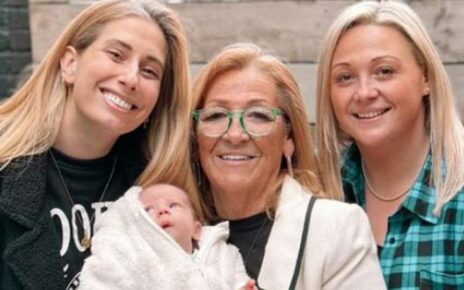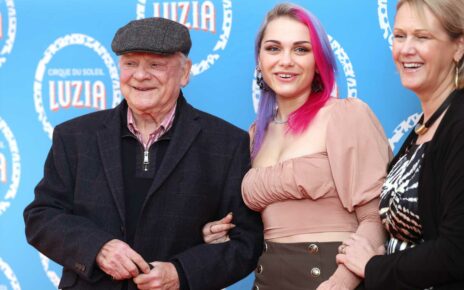

“Inu-Oh” (screening theatrically from GKids) represents Masaaki Yuasa’s summary statement about animation, music, history, and rebellion. It’s the culmination of his wildly imaginative and deeply compassionate work about honoring marginalized people. He takes everything he’s explored in “Lu Over the Wall,” “Mind Game,” “Ride Your Wave,” and “The Night Is Short, Walk on Girl,” and explodes it in “Inu-Oh.”
The film’s an anime rock opera set in 14th century feudal Japan about the friendship between two cursed musical performers, who serve as historical versions of modern-day stars with theatrical fearlessness: the real-life, enigmatic Inu-Oh (Avu-chan from fashion punk Queen Bee), a Noh dancer who dramatizes the Heike’s slaughter at sea in the Battle of Dan-no-ura, and Tomona (Mirai Moriyama), a blind biwa player who chronicles the story in song. But the way Yuasa assaults us with dazzling imagery and musical performance, he comes off as the Baz Luhrmann of anime. It’s a phantasmagorical, stream of consciousness extravaganza (with substantial historical and supernatural backstory), serving as a bridge between the past and present, compelling us to embrace our identities and rediscover our humanity.
If that’s a lot to unpack, so is “Inu-Oh,” which was adapted from Hideo Furukawa’s novel, “The Tale of the Heike: The Inu-Oh Chapters.” “What interested me about the story was, one thing, that I had never done a period piece,” Yuasa told IndieWire through a translator. “So I thought that would be an interesting challenge. And the fact that this story is about an old performer who actually existed. To tell a fictionalized story of what was imagined was also interesting. And the biwa priests and the stories that they told about dead soldiers through song and performance [was another challenge].


“Inu-Oh”
GKids
“But I really think the most important aspect was about a pop star of the time. This was something that I always used to think about, and how in modern times we watch Noh performances or Kabuki, I was wondering what it was like for the people back in the Muromachi era [1336 to 1573] and how they felt when they watched these kinds of performances.”
Not surprisingly, it was the close friendship between the co-protagonists that most excited the director. And one of the many reasons that he selected the two leads was because they were childhood friends. “So even during the recording sessions, they would give opinions to each other on improving their character building,” he said. “Also, the two of them as performers are really true to themselves and really free. They try to take work that won’t change them. And they have to perform, and I think that contributed to amplifying their performances. So when I recorded with them, I tried to make it so that Inu-Oh or Tomona were mostly based off of them.”
Meanwhile, the animation team at Science Saru keenly divided the sequences and audaciously embraced a range of styles and moods in collaboration with Yuasa (including line drawings, oil paintings, watercolors, and psychedelic modes). In fact, the scenes from the co-protagonists’ perspectives were assigned to different coloring teams (with the blind Tomona having an abstract watercolor style). Yet the early highlight consists of Inu-Oh’s physical transformation into a bravura dancer, followed by his chance encounter with Tomono and rejoicing among the stars as kindred spirits. The evolution of his dancing gets more refined and sophisticated.


“Inu-Oh”
GKids
“I really think if Inu-Oh had stayed the way he was, he would’ve been really happy,” Yuasa said. “But as he watches his brothers dance, according to his father’s instructions, he also wanted to dance even better than his brothers. But in order to do that, he needed longer legs. So I think the physical transformation of when he first got his long legs was a turning point for him. But also right after that he meets Tomona, which is a life changing event for him because he found this creative partner/buddy. Even for Tmona, too, it was life changing.”
What surprised Yuasa the most, though, was the unconventional approach to animating the festival-like atmosphere of the music and dance performances (David Bowie meets Michael Jackson) to free the spirits of the dead samurai. “I really thought I was going to do it the normal musical approach of having the songs first and then the animation,” he said. “But the communication between me and the composer [Otomo Yoshihide] didn’t go smoothly.
“So, in the end,” he continued, “I just realized that it was like asking him for a score for a movie. Then I figured out that he needed the storyboards first. I figured once I gave him the storyboards, he would do some music and I would have to [redo] some stuff. But, actually, Mr. Otomo, came out with pretty much almost perfect music, according to my storyboarding, so I didn’t have to change much. But it was a lot of back and forth. I drew in some stuff to add to the songs, and then we had the lyrics written, but also adapting to the lyrics we changed the music.”


“Inu-Oh”
GKids
Inu-Oh’s final dance sequence tells its own story about personal and social redemption. The animation starts out muted and becomes more vibrant and outrageous as he reaches a balletic epiphany. “In order to wake up the spirits and hear them, Inu-Oh moved into an up tempo, faster beat,” Yuasa said. “In the ‘Tales of the Heike,’ all of these samurai who worked hard are dead, but they’re at this dragon palace and it’s a very sad place. But Inu-Oh [tells them]…it’s a good place and [they] should be happy. He wants to save them.
“But Inu-Oh discovers that he’s not connecting with the spirits and freeing them, even though he’s telling their story,” Yuasa added. “They communicate that it’s not enough. He needs to tell his story to free him from his curse. It was their answer to his service.”
This serves as a metaphor about the importance of chronicling history. “I think learning about people from the past to determine how we see each other and present ourselves as living here now is one of the [important] themes,” Yuasa said.
Source: Read Full Article


